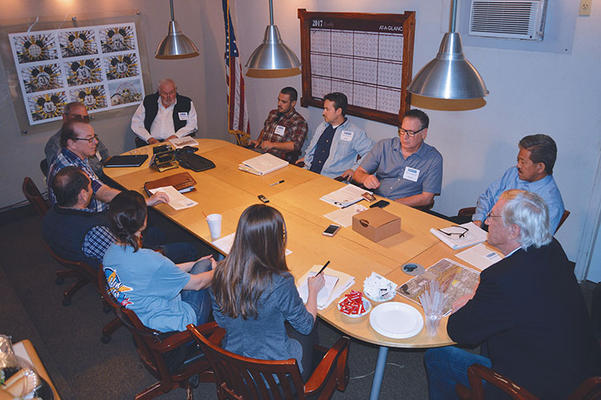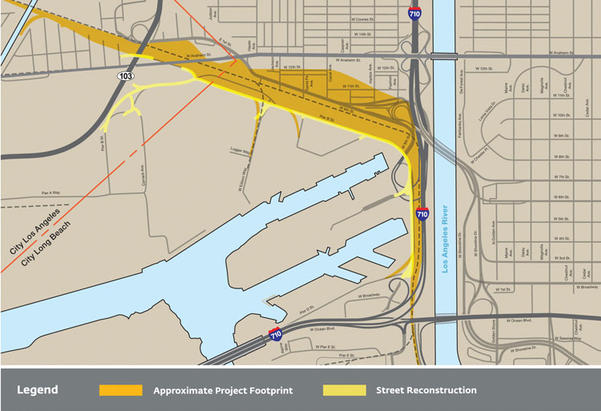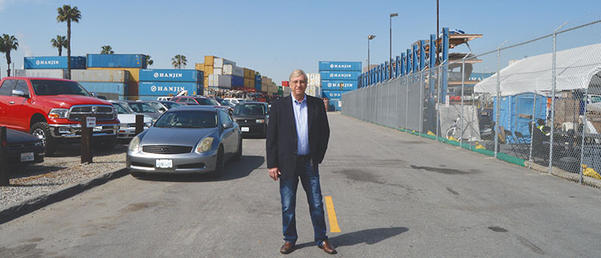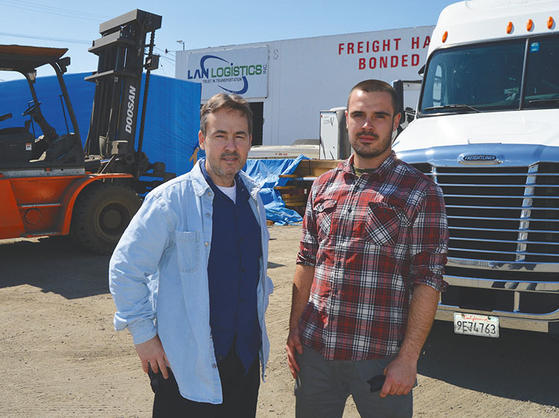In Westside Long Beach, the tune of a dance that has been danced many times before is starting to crescendo. It’s a ditty both sides know by heart – a delicate dialogue between the needs of the longtime businesses in the area and those of the port.
Since at least 2006, the Port of Long Beach has been considering ways to expand its on-dock rail infrastructure at Pier B. In December, the port released a draft environment impact report (EIR) for such a project – one that would expand Pier B’s rail footprint by as much as 100 acres from Pier B Street as far north as 12th Street, which is just south of Anaheim Street, in Westside Long Beach.

Earlier this month, the Long Beach Business Journal met with Westside business and property owners at the offices of Superior Electrical Advertising on West Anaheim Street to discuss the Port of Long Beach’s proposed Pier B rail expansion project. (Photograph by the Business Journal’s Larry Duncan)
There are two other considerations that will ultimately be presented to the Long Beach Board of Harbor Commissioners – one that takes the project to 10th Street and another to 9th Street. The other alternative would leave the facility as is. As identified in the draft EIR, the 12th Street project is the preferred option.
Thirty-six private parcels of land would have to be acquired by the port in order to move ahead with this project, assuming that it is approved by the harbor commission, according to the draft EIR. The document estimates that up to 36 businesses could be impacted, as Westside businesses often occupy more than one parcel.
According to Richard Cameron, managing director of planning and environmental affairs for the Port of Long Beach, the Pier B on-dock rail expansion project is being pursued for both commercial and environmental reasons.
The project would enable the port to transfer more cargo to more trains directly from the terminal at Pier B, which in turn would reduce truck traffic that would otherwise have to handle that cargo. In doing so, the project would also reduce some traffic bottlenecks and boost throughput.
The preferred 12th Street project would add 31 new yard tracks and five new arrival and departure tracks, according to the draft EIR. It would also add a track at the Dominguez Channel Bridge and four tracks at the Pico Avenue Corridor.
“The core of the project is to add switching and storage track capacity outside of the marine terminals,” Cameron said. The project will help the port compete with other facilities, like the Prince Rupert Port Authority in Canada, which receives a high percentage of discretionary cargo due to its efficient rail operations, he explained.
Some business owners in Westside Long Beach argue that it is not only the businesses in the direct path of the project that will be impacted and perhaps even forced to close, but also those in the immediate area.
On March 15, nearly a dozen business and property owners and executives gathered around a table with the Business Journal to discuss their concerns in a meeting at Superior Electrical Advertising, a long time Westside business located on property between Anaheim Street and 12th Street that would be just feet away from the proposed new rail tracks.
LAN Logistics, a family-owned business at 1520 W. 11th St., is directly in the path of the preferred Pier B rail expansion project. “My family has occupied that site for well over 20 years – several generations, including generational employees,” Kevin Donaldson, operations manager at LAN, told the Business Journal. “The issue is the project would eliminate our facility.”
The nature of the firm’s work – moving goods and cargo for major companies like Siemens and entities that are “sensitive in nature” – necessitates that it remain at the port, according to Donaldson. “We handle oversize and overweight loads which require us being very close to the port for safety measures, and it can’t really be done anywhere else,” he said.
John Donaldson, owner of LAN Logistics, indicated that his business is already being impacted. “Just the word of this project getting out to my customers is starting to really make them nervous, because we are in contracts with these people,” Donaldson said.
Owners of businesses located adjacent to the project, such as Superior Electrical and Phillips Steel Co., are also concerned that their businesses and employees could be at risk.
Phillips Steel, which celebrated its centennial in 2015, has been moved twice by the city and port, although that was many years ago. It has occupied its current site at 1368 W. Anaheim St. since 1930, according to owner Daryl Phillips. The business occupies about 125,000 square feet.
“We have had some knock-down drag-outs with the City of Long Beach and the port,” Phillips said. “We have always settled them equitably, and everything has worked out. The trouble with this project is . . . there is really no place for us to go.”

This map shows the footprint of the preferred project option for rail expansion at Pier B at the Port of Long Beach. (Map provided by the Port of Long Beach)
As reported by the Business Journal in February, the vacancy rate of industrial real estate in Long Beach is around 1%. In the entire South Bay, it is even less than that.
“Where am I going to go find 120,000 square feet? It’s simply impossible,” Phillips said. “And if they are going to move me, if they are going to compensate me through eminent domain with a bunch of money, what am I supposed to do with it? There is nowhere to go. I lose my location. I lose my access to 75% of my customers that are within a 15-mile radius.”
While Phillips’ business is not in the direct path of the preferred project, it is close enough that traffic impacts could make it prohibitive to transfer materials on- and off-site.
Phillips asked if the port has determined whether the project would generate as much revenue as the tax revenue generated by the businesses that would have to relocate. The Business Journal put this question to Cameron, who said that a cost-benefit analysis has been conducted but not at that level. “We can’t put it in a CEQA document that way, but we definitely will be looking at that,” he said.
Stan Janocha, chief operating officer of Superior Electrical, noted that it might be difficult for him to find qualified employees with the future of his business in question. “If this ever passes and it’s publicized and it’s all over the place, we may have an issue of hiring qualified people,” he said. His colleague, Senior Vice President Doug Takeshi, noted that it could also make retaining employees difficult.
Takeshi added, “Similar to Daryl, we’re sitting on about 100,000 square feet of property. We need a certain percentage of property under roof, and [we need] open yard space. We need to have parking for over 100 vehicles. It would be very difficult to find something around the Long Beach area.”
The preferred project and both alternatives would eliminate ramps to the Shoemaker Bridge, which connects the Westside to Downtown Long Beach.
Vince Passanissi, president of Marisa Foods and Santa Fe Importers, a food manufacturing facility and restaurant/deli business in the Westside since 1947, is concerned that these traffic reconfigurations might hurt his business, which is located a few blocks north of the proposed project.
“We have a tremendous amount of customers that come in to our restaurant from Downtown Long Beach, from the port, from the refineries [and] Carson,” Passanissi said. “Our entire livelihood is dependent on access to downtown and to the port. And without that access with the changing infrastructure in this project, we could see huge decreases in our business.”
Cameron pointed out that a proposed project by the City of Long Beach and Caltrans as part of the I-710 Corridor Improvement Project seeks to replace the Shoemaker Bridge altogether, which would also result in the closure of the ramps.
Multiple business owners said they were unaware of the project until recently. Sotiria Contos, whose family business, Golden Star Restaurants, has had a Westside Long Beach location since 1963, said that the port had “zero transparency” in the process.
According to the draft EIR, the port conducted public scoping meetings for the EIR process, required by the California Environmental Quality Act (CEQA), twice in September of 2009. E-mail blasts were sent out to “the port’s database of subscribers” to advise of these meetings. The draft EIR also states, “E-mail updates have been sent to business and industry groups on an ongoing basis. Meetings with individual community groups have been conducted on an as-invited basis.”
Jim Sterk, CEO of Superior Electrical, recently spoke with other local businesses to see if they knew about the project. “I went door to door talking to some businesses, Spun Products being one of them,” he said, referring to a business at 1800 W. 9th St. that is in the direct path of the project. The business has been located in the Westside since the early 1970s.
“I met the general manager over there, and I told him what was happening. And I gave him a little brochure and all that stuff, and he said, ‘I don’t know what you’re talking about,’” Sterk said.
Lee Wilson, whose family has owned the property LAN Logistics sits on for about 50 years, said property owners in the path of the project were first informed in August 2009 by mail, but he then heard little of the project until a notification last December about the release of the draft EIR. “If they could have slipped it under the rug any better, I don’t know how they would have,” he said. “They did not adequately notify the public.”
Eliciting chuckles, Contos quipped, “Meanwhile, City of Long Beach toots their horn that they’re planting trees and opening bike lanes.”
She added, “We’re about to make a train in our backyards that’s going to cause really grave environmental impacts on the Westside. It’s almost as if they say – I’m not quoting them – but I feel like they’re saying, ‘Well, it’s the Westside. It comes with the territory.’” A murmur of agreement rippled around the room. “Shame on them.”
Leaning over the table, she demanded, “Write that down.”
On-dock Rail And The Environment: For Better Or For Worse?
A public pamphlet distributed by the port indicates: “Each train eliminates as many as 750 truck trips, reducing traffic on roads, and trains are 75% more fuel efficient than trucks.” The pamphlet also states that on-dock rail facilities generate no truck trips, and thereby reduce roadway congestion and air emissions.
In an interview at the port’s interim headquarters, Cameron noted that Pacific Harbor Line – the short-haul rail that would be responsible for creating trains at the expanded facility – has “the cleanest short line fleet of locomotives in the world.” He also noted that the port is looking into opportunities to develop cleaner rail technologies.
The port projects growth in the coming years, which means increased traffic overall. But “the goal is to try to get as much overall truck trip reductions [as possible],” Cameron explained. “What we need to make sure is we keep up with that growth and not increase truck trips but stabilize or minimize to the best of our ability without hampering any type of economic [factors].”

Stan Janocha, chief operating officer of Superior Electrical Advertising, stands in the middle of 12th Street, with his company’s facilities at right. The proposed Pier B rail project would butt up to where the curb is shown on the left. The 55-year-old company boasts clients such as Disney, McDonald’s, Universal City Walk, nearly all national movie theaters, Best Buy and many more. (Photograph by the Business Journal’s Larry Duncan)
In considering environmental benefits, Cameron said a number of factors must be looked at collectively. “You have noise reduction. You don’t have trucks going through neighborhoods that want to get to ICTF [the Intermodal Container Transfer Facility] or down the I-710,” he said. “I would rather have a train versus trucks going through neighborhoods from a health risk perspective.”
However, Cameron qualified, “We are not making claims that this project is going to clean up the air. What it does do, it does help us overall with the emission reductions from one mode to another.”
The draft EIR states that the construction and future operation of the preferred 12th Street expansion of Pier B’s on-dock rail would make a “cumulatively considerable and unavoidable contribution to a significant cumulative impact for emissions of six air pollutants,” including volatile organic compounds (VOC), carbon monoxide (CO), nitrogen oxides (NOx), particulate matter emissions (PM10 and PM2.5), and “possibly sulfur oxides (SOx).”
Additionally, “With regard to odors, due to the large number of sources within and near the project site that emit diesel emissions, and the proximity of residents to industrial operations, odorous emissions in the project region are considered a significant cumulative impact.” However, due to the “mobile nature” of these odor sources, “the project would be likely to result in only minor changes in the overall odor environment in the vicinity.”
The draft EIR also states that the project would contribute to “individual cancer risk, population cancer burden and non-cancer effects from acute (short-term) exposure,” but that none of these risks would exceed acceptable thresholds after mitigation.
“I am not going to sit here and tell you it’s the cleanest,” Cameron said. “Over time, we would hope through efforts like our Clean Air Action Plan, working with our partners and the Class 1 [rail lines] that they will . . . continue to push for cleaner rail operations.”
Still, Cameron believes the cumulative effects of the project could have benefits.
“So if you start to think about the benefits of the project producing an overall two to three [additional] trains per day leaving the complex at a minimum, you’re looking at reducing 1,500 truck trips that otherwise were going to go out the gate,” he said.
All business and property owners interviewed by the Business Journal were concerned about environmental impacts associated with the project.
“It will be the environmental issues of that location that will affect us gravely,” Phillips said, noting that his business backs up to 12th Street. “The bad part is we employ 65 or so families – and when I say families, when you’ve been in business for 100 years, they are family,” he said. “We’re subjecting them to environmental issues that we have no control over that no one is taking any responsibility for.”
Phillips added, “I want it on the record that I am not opposed for a minute to redevelopment or development as long as it’s done properly. And this is a project that is not well thought out for the better of the community, the Westside, the City of Long Beach [or] the County of Los Angeles.”
Passanissi had similar concerns. “We have numerous employees that live in the area and come to work every day that are worried about environmental issues that are going to affect their health,” he said.
Contos, too, was worried about her business’s employees. “Our employees are like our family, and I stand behind them and I protect them. If I don’t have them, I don’t have a business,” she said. Most of her employees live within a mile of the restaurant, she noted. “I don’t want my employees walking to work, compromising their health. It’s wrong.”
Many of Golden Star’s regular customers are truck drivers. “The truck drivers were told a few years back that they must make changes accordingly to their trucks such that the trucks run green. All truck drivers complied,” she said. “Those truck drivers that they are saying they are going to take off the 710 Freeway were told to do something, and they did it.”
What Now?
The comment period for the draft EIR has closed. Several of the business and property owners who spoke with the Business Journal indicated they have met with port staff individually but not as a group. Some have met with their councilmember, Lena Gonzalez, who also represents the port. Additionally, most submitted comments on the draft EIR, and a few submitted letters from legal representation.
Asked for comment, Gonzalez wrote in an e-mailed statement: “I have personally met with our harbor department as well as the business community regarding Pier B. There are many issues to consider, especially as local West Side businesses will be greatly impacted. I look forward to hearing more as the process continues.”
“They said, ‘We will listen.’ And they have. They have listened,” John Donaldson said. “Then they say, you know, ‘Submit your complaints in writing.’ We have. I don’t know what they’re thinking.”
Port staff is currently going through comments submitted on the draft EIR, according to Cameron. “We extended the comment period 30 days and had another public hearing because we found out that not all the stakeholders were getting the notifications,” he said.
“We would sit down and will continue to meet with business owners and property owners and all stakeholders,” Cameron said. “In fact, we are probably going to want to at some level have a variety of different meetings with these commenters.”
Once comments have been addressed, the port will determine if it needs to reissue the draft EIR or portions of it and what the ensuing timeline will be, according to Cameron. “Probably within the next three to four weeks, we will have a better sense of a new timeline. We do not want to rush this. We believe this is a good project,” he said.

John and Kevin Donaldson’s 20-plus year old business, LAN Logistics, would be uprooted if the preferred plan to expand rail at Pier B is approved. Their operations require direct proximity to the port. (Photograph by the Business Journal’s Larry Duncan)
Cameron said that acquiring properties via eminent domain is “the last approach we want to take.” He explained, “The last thing we want to do is displace, but that’s kind of where we are right now with figuring out how to move forward with the project in a way that minimizes those types of impacts.”
While port staff is currently working to determine which businesses will be impacted and how to develop a means to mitigate or reduce those impacts, he noted that it’s “a little bit of the chicken before the egg” to make determinations before the harbor commission votes on the project or one of its alternatives.
“So what our focal point is right now is, did we do CEQA right?” Cameron explained. “A lot of what we are sifting through right now . . . are comments with people not being happy about losing access, people not being happy about losing their businesses. And we respect that. And so that’s what we’re kind of going through right now.”
Meanwhile, the businesses of the Westside are busy gathering signatures opposing the project, according to Paul Collins, architect and owner of PAC Designs on the Westside.
“We sent out a petition. We put it out one week ago, and we’ve collected 1,000 names,” Collins said. “We suspect with the neighborhoods . . . that we will have between 15,000 and 20,000 signatures very soon. We’re going to continue collecting signatures. The neighborhoods are really upset. They don’t know anything about it at all.”
Collins said in the end, he just wants the port to remain true to the tenets of its Green Port Policy – a series of programs aimed at reducing environmental impacts of its operations.
“We have 135 employees. Forty-one of those employees are Long Beach residents, and we hire Long Beach residents,” Janocha said. “If we had two equal people [apply] and one was from Long Beach, they would get the job. We are very loyal to the City of Long Beach. One of my biggest concerns is, how loyal is the city to Westside businesses? How loyal are they to us?”
